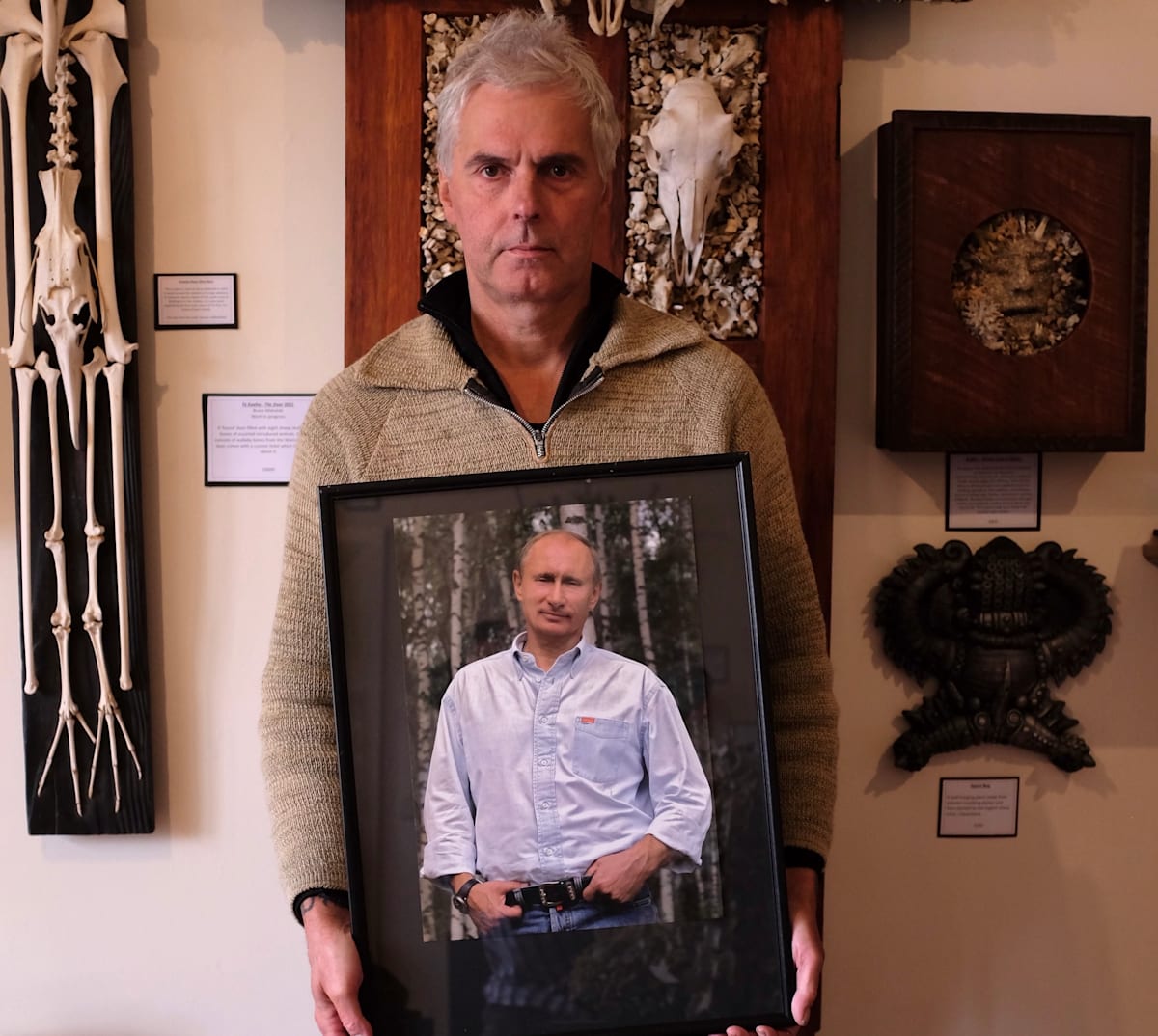
Mural painter Bruce Mahalski enlivens city streets, peppers public places with enigmatic posters, runs his own museum and stops trains - usually in the name of environmental causes.
Dunedin artist Bruce Mahalski is out to save the world one wall at a time.
Mahalski, whose many forms of protest at the path the planet is on include mural painting, has decorated dozens of walls in Dunedin, the length of New Zealand and overseas.
Very often, his murals feature extinct furry animals, sea life - he studied marine biology - and other creatures that are endangered or have met an untimely death.
Such is the case with Sultan and Sonia, Barbary lions that bring a splash of colour to an alley off Dunedin’s main drag, George St. Known as the Lawrence lions, the pair made off from a circus in the Clutha District town on a night in 1978. Attempts were made to recapture them, but they were eventually shot.
A community group raised the money to have the lions stuffed and they have pride of place in Otago Museum’s Animal Attic gallery, a collection from which Mahalski often takes inspiration.
Extinction rebel
“I’m painting animals that are on the verge of extinction or that have already become extinct. I see a lot of my murals as memorials to animals that I like.”
He does murals - either spraying or brushing - to order, in a preferred palette of black, white and grey. If he can persuade the owner of a wall to have it adorned with a creature from the museum’s taxidermy collection, which dates back to the late 1800s and has exhibits from all over the world, chances are it will cost them little more than the price of the paint.

“If I can paint an animal from the Animal Attic, I might do it for free if it’s on a high-profile wall, normally with a little bit of money for my expenses. But if someone asks me to paint Mr T, as I did the other day, or Freddie Mercury, I’ll charge $40 an hour.”
Murals alone don’t provide Mahalski with a living. They represent about a third of his income, with the rest coming from his Dunedin Museum of Natural Mystery - featuring, besides much else, exotic skeletal remains, including bone artworks that he creates - and illustration work.
Train stopping
Apart from the Otago Daily Times headlines Mahalski’s murals frequently attract, he has also been in the news for a more direct form of protest.
On a Saturday morning last December, he and several Extinction Rebellion activists were arrested for stopping a coal-laden KiwiRail train. It was on its way through Dunedin from Bathurst Resources’ Takitimu mine in Southland to a Fonterra milk powder plant at Temuka in South Canterbury.
“We’ve been stopping trains for quite a while - this is the sixth one - so I’m surprised it took this long to be arrested. I’m not going to say how many I’ve been involved with.”
Mahalski won’t be wanting too many details of his coal train exploits to be made public before he defends himself in court on charges he says could cost him and seven fellow protesters up to $64,000. However, he is clear about the basis of what he’ll be arguing in court.

Coalamity
He anticipates incorporating in his personal defence a July 2021 paper in the journal Nature Communications, “The mortality cost of carbon”, by US climate-change economics researcher Daniel Bresler. Bresler has worked out how many heat-related deaths can be attributed to a known amount of carbon emissions, which Mahalski translates into Fonterra coal trains.
“For every 4434 tonnes of carbon dioxide put into the atmosphere from 2020, one person will die prematurely from heat-related causes by the end of the century. So the coal carried by that train will kill a person every five days. We stopped the train to save lives.”
He is dismayed that state-owned company KiwiRail hauls the stuff around the country and majority government-owned Huntly power station gobbles up coal at a great rate. “Yet the Government has declared a climate emergency.” Fonterra, meantime, has committed to phasing out its coal use by 2037.
When the protesters do get to court, their case is unlikely to be helped by the fact that an excursion train to Oamaru, The Victorian, was also stopped — without cause, according to Mahalski. During previous protests, he says, other trains have continued to run.
No politics, please
Mahalski confines his protests to direct action and posters, believing the public doesn’t have an appetite for murals that carry political messages. If a tagger has a go at his work, he’s not greatly upset. When someone added their mark to a mural he did of yellow eyed penguins, he repainted the wall with the Lawrence lions.
“Taggers have just as much legitimacy as I do.” The difference is that he usually has permission, although not so for his latest effort, a kōura on top of some tagging on a wall near the city’s Ross Creek reservoir.
“I did it because I thought it was a good thing.”
Poster boy
It’s not all protest art and action from Mahalski, however. He is the instigator of the Great Kiwi Poster Competition, open to five-to-21-year-olds on the theme Kia Pai Ake Tātou - We Can Do Better, the winning entries of which are being displayed up and down the country.

Mahalski says his staging of the competition, the latest of which is the third and was sponsored by Phantom Bill Stickers, Hell Pizza, arts crowdfunder Boosted and New Zealand’s Biological Heritage, is his answer to critics who claim he is “negative” and a “shit-stirrer”.
“Here is something to point at and say, ‘Hey, I’m not just this dude who sits in front of trains’. Everyone I know who is a serious activist is lobbying, setting up petitions, doing posters, coming at the cause from all angles. It’s a way of being thorough.”
If it plays well in court, he won’t be unhappy, although he insists that isn’t the main motivation.
If he can get sponsors, he would like to run the competition every couple of years. “Art is the ultimate way to communicate and I love putting art on walls. It’s a way to give people a platform.”
Day in court
He guesses he has produced hundreds of posters himself in a 40-year creative career. “A lot of them have been promoting bands because I play in bands, at lot have been environmental and many are political with pacifist and socialist messages.”

For all his feistiness, Mahalski has never been ordered to paint over any of his work.
“It might happen one day. But I don’t do anything that I wouldn’t be proud to stand up in court and defend.”
Made with the support of the Public Interest Journalism Fund








